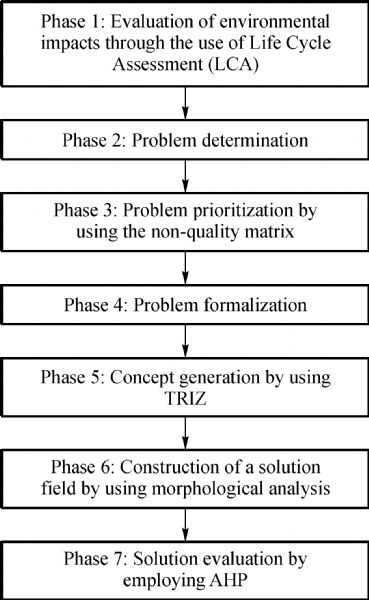

Frontiers of Mechanical Engineering >
Eco-innovative design approach: Integrating quality and environmental aspects in prioritizing and solving engineering problems
Received date: 12 Apr 2014
Accepted date: 31 Jul 2014
Published date: 10 Oct 2014
Copyright
This study proposes an eco-innovative design process taking into consideration quality and environmental aspects in prioritizing and solving technical engineering problems. This approach provides a synergy between the Life Cycle Assessment (LCA), the non-quality matrix, the Theory of Inventive Problem Solving (TRIZ), morphological analysis and the Analytical Hierarchy Process (AHP). In the sequence of these tools, LCA assesses the environmental impacts generated by the system. Then, for a better consideration of environmental aspects, a new tool is developed, the non-quality matrix, which defines the problem to be solved first from an environmental point of view. The TRIZ method allows the generation of new concepts and contradiction resolution. Then, the morphological analysis offers the possibility of extending the search space of solutions in a design problem in a systematic way. Finally, the AHP identifies the promising solution(s) by providing a clear logic for the choice made. Their usefulness has been demonstrated through their application to a case study involving a centrifugal spreader with spinning discs.

Key words: eco-innovation; non-quality matrix; TRIZ; composted product spreading
Mahmoud CHAKROUN , Grigore GOGU , Thomas PACAUD , François THIRION . Eco-innovative design approach: Integrating quality and environmental aspects in prioritizing and solving engineering problems[J]. Frontiers of Mechanical Engineering, 2014 , 9(3) : 203 -217 . DOI: 10.1007/s11465-014-0308-8
| 1 |
Hoffman W F. A tiered approach to design for environment. In: International Conference on Clean Electronics Products and Technology. Edimbourg, 1995
|
| 2 |
Fussler C, James P. Driving Eco-innovation: A Breakthrough Discipline for Innovation and Sustainability. London: Pitman Publishing, 1996
|
| 3 |
Graedel T E, Allenby B R. Design for Environment. London: Prentice Hall, 1996
|
| 4 |
Volvo. Corporate standards for materials. 2012
|
| 5 |
Bombardier. Prohibited and restricted substances for transportation. 2005
|
| 6 |
Chen J L, Liu C C. Green innovation design of products by TRIZ inventive principles and green evolution rules. In: International CIRP Design Seminar. Hong Kong, 2002
|
| 7 |
Chen J L, Liu C C. An eco-innovative design approach incorporating the TRIZ method without contradiction analysis. The Journal of Sustainable Product Design, 2001, 1(4): 263–272
|
| 8 |
Kobayashi H. Strategic evolution of eco-products: A product life cycle planning methodology. Research in Engineering Design, 2005, 16(1–2): 1–16
|
| 9 |
Kobayashi H. A systematic approach to eco-innovative product design based on life cycle planning. Advanced Engineering Informatics, 2006, 20(2): 113–125
|
| 10 |
Yen S B, Chen T. An eco-innovative tool by integrating FMEA and TRIZ methods. In: Fourth International Symposium on Environmentally Conscious Design and Inverse Manufacturing. Tokyo: IEEE, 2005, 678–683
|
| 11 |
Fresner J, Jantschgi J, Birkel S, Bärnthaler J, Krenn C. The theory of inventive problem solving (TRIZ) as option generation tool within cleaner production projects. Journal of Cleaner Production, 2010, 18(2): 128–136
|
| 12 |
Yang C J, Chen J L. Accelerating preliminary eco-innovation design for products that integrates case-based reasoning and TRIZ method. Journal of Cleaner Production, 2011, 19(9–10): 998–1006
|
| 13 |
Jones E, Harisson D, McLaren J. Managing Creative Eco-innovation. The Journal of Sustainable Product Design, 2001, 1(1): 27–39
|
| 14 |
Vezzoli C, Manzini E. Design for Environmental Sustainability. London: Springer, 2008
|
| 15 |
Terninko J, Zusman A, Zlotin B. Systematic Innovation: An Introduction to TRIZ. Boca Raton: CRC Press, 1998
|
| 16 |
Portwood B, Reising L. Root cause analysis and quantitative methods–Yin and Yang? In: Proceedings of the 25th International System Safety Conference. Baltimore: System Safety Organization, 2007
|
| 17 |
Altshuller G S. Creativity as an Exact Science. New York: Gordon & Breach, 1988
|
| 18 |
Altshuller G S. And Suddenly the Inventor Appeared: TRIZ, the Theory of Inventive Problem Solving. 2nd ed. Worcester: Technical Innovation Center, Inc., 1994
|
| 19 |
Salamatov Y. TRIZ: The Right Solution at the Right Time. Enschede: Insytec B V, 1999
|
| 20 |
Savransky S. Engineering of Creativity: Introduction to TRIZ Methodology of Inventive Problem Solving. Boca Raton: CRC Press, 2000
|
| 21 |
Maier M W, Rechtin E. The Art of Systems Architecting. 2nd ed. Boca Raton: CRC Press, 2000
|
| 22 |
Zwicky F. Discovery, Invention, Research—Through the Morphological Approach. Toronto: The Macmillan Company, 1969
|
| 23 |
Zwicky F, Wilson A G. New Methods of Thought and Procedure. Contributions to the Symposium on Methodologies. Berlin: Springer, 1967
|
| 24 |
Pomerol J C, Barba-Romero S. Choix Multicritère Dans L’Entreprise. Paris: Hermes Science Publications, 1993
|
| 25 |
Saaty T L. How to make a decision: The analytic hierarchy process. European Journal of Operational Research, 1990, 48(1): 9–26
|
| 26 |
Saaty T L. The Analytic Hierarchy Process. New York: McGraw-Hill, 1980
|
/
| 〈 |
|
〉 |